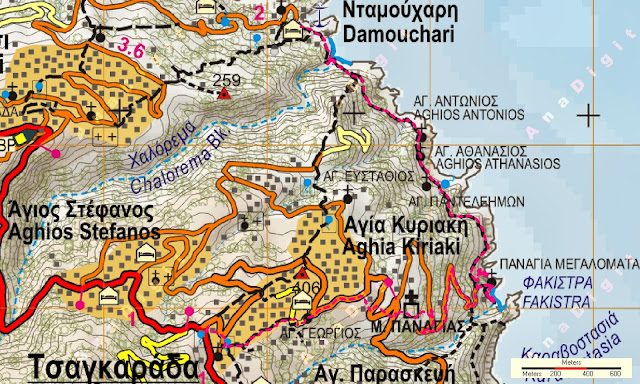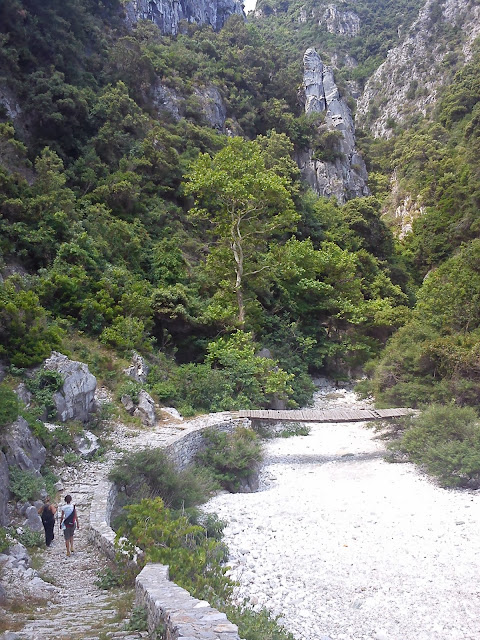Duration: 3,5 hours with stops (walking time 3 h)
Altitude: from 195 m. (Fitoko) to 700 m. (max) to 620 m. (Makrinitsa square)
Signing: red marks, a few signs
Drinking water on walk: no
Download GPS track: from Everytrail from Wikiloc
The area of Fitoko previously belonged to the community of Makrinitsa. Although this route passes over mostly stony ground with low vegetation, we are compensated by the panoramic views towards Makrinitsa, Portaria, Volos and Pagasitikos Gulf, as far as the villages of Sesklo and Kapourna. Walking is not recommended for hot summer days with strong sunshine, as there is hardly any shade, but is particularly suitable for winter (October to April). Vegetation near Fitoko and Klima in the first half of the route may be thick in places. We can go to Fitoko by taxi and return from Makrinitsa to Volos by bus (www.ktelvolou.gr), or walking down to Aidonofolies and then take city bus nr. 4.
We
can start out from the parking lot at the main church of Panagia
(the Virgin Mary) at Fitoko. A narrow asphalt road leading to the
houses of the village starts by a shrine near the entrance of the
parking area and we immediately turn left off this on an earth road
that leads down towards a small ravine. We pass by a spring water
drinking fountain (without water) and turn left at the bottom into a
narrower road with a chain across it (walk over the chain). A few metres before the road
ends, there is an obvious and fairly wide path-kalderimi to our
left that zigzags uphill. For a short distance, our progress is
hindered by prickly pears before we reach an old spring
water drinking fountain. A little
further up, the path emerges onto an earth road which we follow uphill. That road also comes from the main church of Fitoko. A road goes off to the right, but we continue
straight ahead. Further up at a triple junction we turn right, then right
again at the next junction and to the left at the following
junction (watch out for the red marks).
 |
| View to Fitoko (to the right) |
In a short while we see the path on the left of the road, but it is
closed by vegetation and we walk next to it on a parallel path
through an olive grove. Further on, just below a house, the path
continues up to the right of this and comes out diagonally
onto an earth road which we follow to the right (ignore the yellow paint marks). About a hundred
metres further on, after passing a small hut, we see red marks on the left, which
lead us uphill, on a path that runs next to a fence. The path, which was cleaned recently (autumn 2015), shows signs of kalderimi,
and further on runs next to a water channel for a small distance.
 |
| View to Volos from Vathirema ravine |
We reach the
ridge and the kalderimi/path begins to descend towards a fairly large
ravine (Vathirema). Electric power lines and the road going to the
Kaliakouda and Ksirakia springs can be seen along the opposite side.
We cross the ravine, ascend to the other bank, cross the road and continue up a narrow track that leads shortly up to a cement building of the
water system. We continue, walking now on path on the dry, stony ridge
of Sarakinos with an unrestricted view to the city and sea below. From time to time we
see signs of kalderimi.
The ascent becomes less steep, we walk for a short distance on level ground and then begin to descend towards Makrinitsa, visible at the distance. On our course there is a cross in memory to those who died in the battle of Makrinitsa in 1878 during the Greek uprising against the Turks (Volos joined the state of Greece in 1881).
The ascent becomes less steep, we walk for a short distance on level ground and then begin to descend towards Makrinitsa, visible at the distance. On our course there is a cross in memory to those who died in the battle of Makrinitsa in 1878 during the Greek uprising against the Turks (Volos joined the state of Greece in 1881).
 |
| Patosia stone bridge at Makrinitsa |
Descending amongst some pine trees,
we walk over the stone arched bridge of Patosia and then the path brings us to an
old fountain with no water. We continue straight ahead entering the village and shortly
turn left onto an uphill kalderimi that takes us past the beautiful restored
mansion that houses the Environmental Education Centre. We come out
into the main square of Makrinitsa, right next to the kalderimi that
goes down to Volos.
| Makrinitsa |













